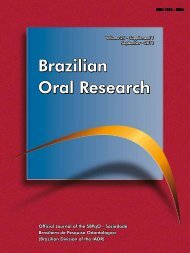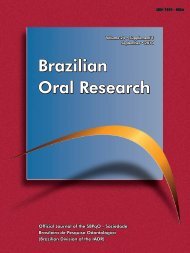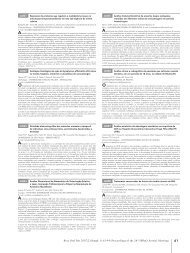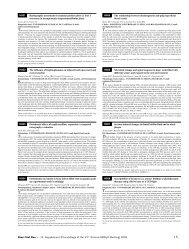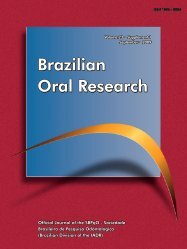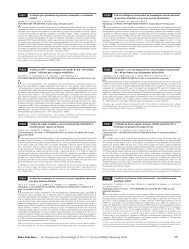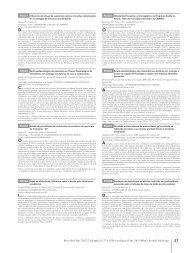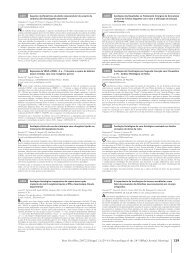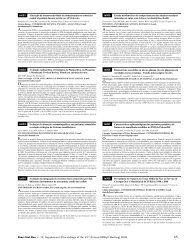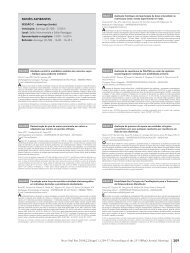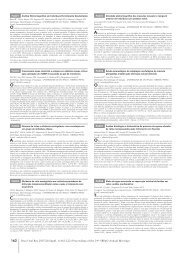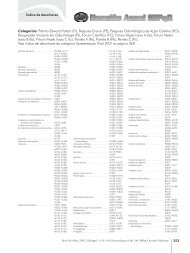Brazilian Oral Research Brazilian Oral Research Brazilian Oral
Brazilian Oral Research Brazilian Oral Research Brazilian Oral
Brazilian Oral Research Brazilian Oral Research Brazilian Oral
Create successful ePaper yourself
Turn your PDF publications into a flip-book with our unique Google optimized e-Paper software.
cus bleeding index and calculus index were factors<br />
significantly related to oral malodor in this study.<br />
Interestingly, Al-Ansari et al. 19 (2006) assessed<br />
the prevalence and factors associated with self-reported<br />
halitosis in 1,551 Kuwaiti patients. The prevalence<br />
of self-reported halitosis was 23.3%. Use of<br />
the toothbrush less than once daily was the factor<br />
most strongly associated with self-perceived halitosis.<br />
Other factors significantly associated with selfperceived<br />
halitosis included current or past smoking,<br />
female gender, being 30 years of age or older,<br />
having high school education or less, history of<br />
chronic sinusitis or gastrointestinal disorders, never<br />
using miswak (a natural toothbrush made from<br />
the twigs of the Salvadora persica tree), and never<br />
using dental floss. They concluded that inadequate<br />
oral hygiene practices were the factors most strongly<br />
associated with self-reported oral malodor in this<br />
sample of Kuwaiti patients. Other factors with significant<br />
associations included history of gastrointestinal<br />
tract disorders, chronic sinusitis, older age,<br />
female gender, and lower education levels.<br />
Therapeutic approach to manage<br />
oral halitosis<br />
Successful treatment of halitosis depends on<br />
a correct diagnosis and the implementation of a<br />
cause-related therapy. 20 After a positive diagnosis<br />
for oral halitosis has been made, the treatment plan<br />
is implemented, which comprises elimination of the<br />
causative agent and improvement of the oral health<br />
status. 21 Although the multiple possible etiologies<br />
include oral and non-oral causes, the majority of<br />
breath malodor cases originate from the oral cavity.<br />
Briefly, the treatment of oral malodor can therefore<br />
be focused on the reduction of the intraoral bacterial<br />
load and/or the conversion of VSC to nonvolatile<br />
substrates.<br />
Miyazaki et al. 22 (1999) established the recommended<br />
examination for halitosis and a classification<br />
of halitosis with corresponding treatment needs.<br />
Accordingly, different treatment needs (TN) have<br />
been described for the various diagnostic categories.<br />
The responsibility for the treatment of physiologic<br />
halitosis (TN-1), oral pathologic halitosis (TN-1<br />
and TN-2), and pseudo-halitosis (TN-1 and TN-4)<br />
Cortelli JR, Barbosa MDS, Westphal MA<br />
resides on dental practitioners. However, extra-oral<br />
pathologic halitosis (TN-3) and halitophobia (TN-<br />
5) should be managed by a physician or medical<br />
specialist and a psychiatrist or psychological specialist.<br />
Table 1 describes the 5 different categories of<br />
treatment needs according to diagnosis (Miyazaki et<br />
al. 22 , 1999).<br />
The management of halitosis starts by taking a<br />
detailed history of the condition, duration, severity,<br />
and impact on the patient’s everyday life. Examination<br />
involves clinical, radiographic, and special tests.<br />
The contributing medical conditions, once identified,<br />
are referred for treatment accordingly. Clinical examination<br />
checks the patient’s oral hygiene, caries, and<br />
periodontal status; plaque retention factors are also<br />
recorded. Radiographic examination should look for<br />
evidence of dental caries, alveolar bone defects, and<br />
defective restorations. 21 Special tests are performed<br />
to detect the foul-smelling VSCs along with the associated<br />
bacteria. The results collected can be used<br />
to confirm the diagnosis and to monitor the treatment<br />
progress. There are many diagnostic techniques<br />
among which are organoleptic measurement, gas<br />
chromatography, and halimeter examination. 23,24,25,26<br />
Since malodor originating from the mouth is due<br />
to the metabolic degradation of available proteinaceous<br />
substrates to malodorous gases by certain oral<br />
microorganisms, oral malodor can be ameliorated<br />
through: (1) Reduction of bacterial load, (2) reduction<br />
of nutrient availability, (3) conversion of VSC to<br />
nonvolatiles and (4) masking the malodor. 1,20,27<br />
Table 1 - Treatment needs (TN) for breath malodor divided<br />
in 5 categories.<br />
Category Description<br />
TN-1<br />
TN-2<br />
Explanation of halitosis and instructions for oral<br />
hygiene (support and reinforcement of a patient’s<br />
own self-care for further improvement of his/her oral<br />
hygiene).<br />
<strong>Oral</strong> prophylaxis, professional cleaning and treatment<br />
of oral diseases, especially periodontal diseases.<br />
TN-3 Referral to a physician or medical specialist.<br />
TN-4<br />
TN-5<br />
Explanation of examination data, further professional<br />
instruction, education and reassurance.<br />
Referral to a clinical psychologist, psychiatrist or other<br />
psychological specialist.<br />
Braz <strong>Oral</strong> Res 2008;22(Spec Iss 1):44-54<br />
4



